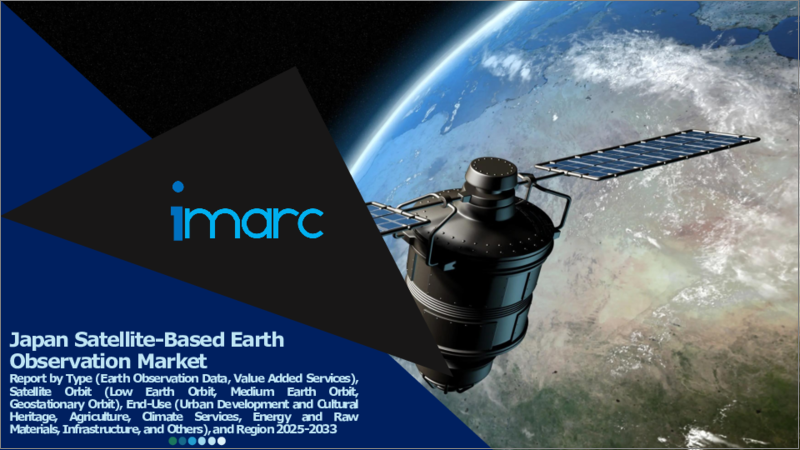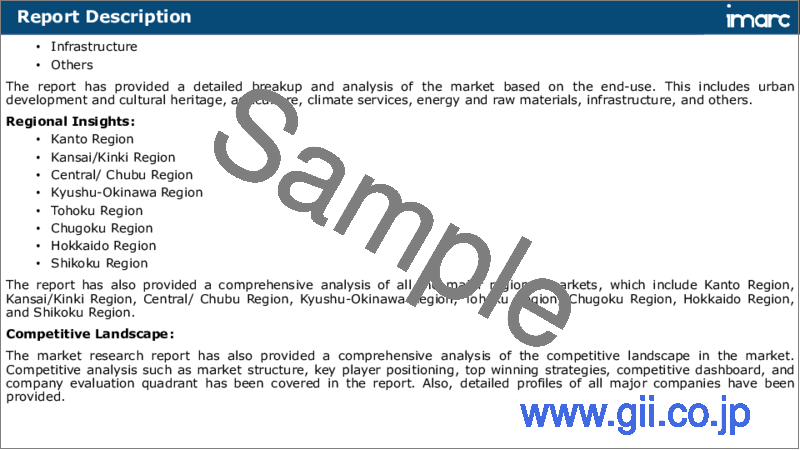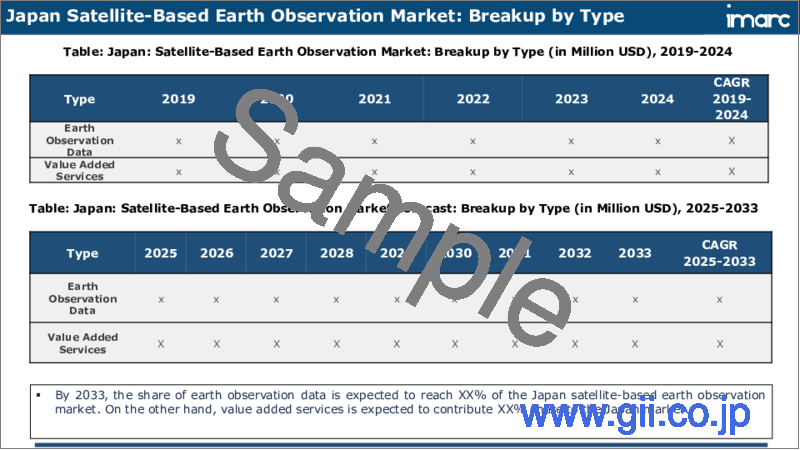|
|
市場調査レポート
商品コード
1609763
日本の地球衛星観測市場レポート:タイプ別、衛星軌道別、最終用途別、地域別、2025年~2033年Japan Satellite Based Earth Observation Market Report by Type, Satellite Orbit, End-Use, and Region 2025-2033 |
||||||
カスタマイズ可能
|
|||||||
| 日本の地球衛星観測市場レポート:タイプ別、衛星軌道別、最終用途別、地域別、2025年~2033年 |
|
出版日: 2024年12月05日
発行: IMARC
ページ情報: 英文 122 Pages
納期: 5~7営業日
|
全表示
- 概要
- 目次
日本の地球衛星観測市場規模は、2024年に2億3,210万米ドルに達しました。今後、IMARC Groupは、市場は2033年までに6億2,440万米ドルに達し、2025年から2033年の間に11.6%の成長率(CAGR)を示すと予測しています。地球衛星観測は、国境監視、軍事活動の追跡、国家安全保障活動の支援に役立つため、情報・監視・偵察(ISR)目的での利用が増加していることが、主に市場を牽引しています。
本レポートで扱う主な質問
- 日本の地球衛星観測市場はこれまでどのように推移してきたのか、また今後数年間はどのように推移するのか?
- COVID-19が日本の地球衛星観測市場に与えた影響は?
- 日本の地球衛星観測市場のタイプ別の内訳は?
- 日本の地球衛星観測市場の衛星軌道別の内訳は?
- 日本の地球衛星観測市場の最終用途別の内訳は?
- 日本の地球衛星観測市場のバリューチェーンにはどのような段階がありますか?
- 日本の地球衛星観測における主要な促進要因と課題は何か?
- 日本の地球衛星観測市場の構造と主要プレーヤーは?
- 日本の地球衛星観測市場における競合の程度は?
目次
第1章 序文
第2章 調査範囲と調査手法
- 調査の目的
- ステークホルダー
- データソース
- 市場推定
- 調査手法
第3章 エグゼクティブサマリー
第4章 日本の地球衛星観測市場:イントロダクション
- 概要
- 市場力学
- 業界動向
- 競合情報
第5章 日本の地球衛星観測市場情勢
- 過去および現在の市場動向(2019年~2024年)
- 市場予測(2025-2033)
第6章 日本の地球衛星観測市場:タイプ別の内訳
- 地球観測データ
- 付加価値サービス
第7章 日本の地球衛星観測市場:衛星軌道別の内訳
- 低軌道
- 中軌道
- 静止軌道
第8章 日本の地球衛星観測市場:最終用途別の内訳
- 都市開発と文化遺産
- 農業
- 気候サービス
- エネルギーと原材料
- インフラストラクチャー
- その他
第9章 日本の地球衛星観測市場:競合情勢
- 概要
- 市場構造
- 市場プレーヤーのポジショニング
- 主要成功戦略
- 競合ダッシュボード
- 企業評価象限
第10章 主要企業のプロファイル
第11章 日本の地球衛星観測市場:業界分析
- 促進要因・抑制要因・機会
- ポーターのファイブフォース分析
- バリューチェーン分析
第12章 付録
Japan satellite-based Earth observation market size reached USD 232.1 Million in 2024. Looking forward, IMARC Group expects the market to reach USD 624.4 Million by 2033, exhibiting a growth rate (CAGR) of 11.6% during 2025-2033. The increasing usage of satellite-based Earth observation for intelligence, surveillance, and reconnaissance (ISR) purposes, since they help in monitoring borders, tracking military activities, and supporting national security efforts is primarily driving the market.
Satellite-based Earth observation is the practice of collecting crucial data about Earth's physical, chemical, and biological systems through remote sensing technologies and survey methods conducted from orbiting satellites. This data plays a pivotal role in forecasting climate patterns, tracking weather fluctuations, monitoring potential disasters and natural catastrophes, identifying oil and mineral deposits, and assessing the availability of water resources. Numerous regional organizations are increasingly depending on satellite-based Earth observation systems to acquire precise and invaluable information for the purpose of data analytics. These systems offer a unique vantage point, enabling the acquisition of comprehensive, real-time data on various Earth-related phenomena. Whether it's monitoring crop health for agricultural planning, tracking deforestation for environmental conservation, or assessing urban sprawl for sustainable development, satellite-based Earth observation provides a wealth of insights that can inform decision-making across diverse sectors. This technology has revolutionized the ability to understand and manage the planet, making it an indispensable tool for addressing regional challenges and fostering sustainable practices.
Japan Satellite-Based Earth Observation Market Trends:
Governments in Japan are promoting the adoption of smart and precise farming techniques due to concerns like decreasing arable land and escalating food security issues. This drive underscores the growing significance of satellite-based Earth observation systems in guiding agricultural practices with valuable information. Furthermore, the deterioration of forested areas, critical for safeguarding people and infrastructure against natural disasters like avalanches, landslides, and rockfalls, has intensified the demand for satellite-based Earth observation in managing protected forests sustainably. In addition to this, satellite-based Earth observation is gaining momentum in sustainable urban planning and rural development, offering high-resolution satellite imagery to monitor urban transformation processes effectively. Moreover, the extensive utilization of high-precision datasets in defense and intelligence sectors for activities such as land surveillance, airfield monitoring, safeguarding critical infrastructure, and crime mapping is contributing significantly to market growth. In addition to this, the emerging trend of automated self-driving vehicles is poised to stimulate the adoption of satellite-based Earth observation systems for navigation and various applications within cars. These multifaceted factors collectively fuel the expansion of the satellite-based Earth observation market in Japan.
Japan Satellite Based Earth Observation Market Segmentation:
Type Insights:
- Earth Observation Data
- Value Added Services
Satellite Orbit Insights:
- Low Earth Orbit
- Medium Earth Orbit
- Geostationary Orbit
End-Use Insights:
- Urban Development and Cultural Heritage
- Agriculture
- Climate Services
- Energy and Raw Materials
- Infrastructure
- Others
Competitive Landscape:
The market research report has also provided a comprehensive analysis of the competitive landscape in the market. Competitive analysis such as market structure, key player positioning, top winning strategies, competitive dashboard, and company evaluation quadrant has been covered in the report. Also, detailed profiles of all major companies have been provided.
Key Questions Answered in This Report:
- How has the Japan satellite based earth observation market performed so far and how will it perform in the coming years?
- What has been the impact of COVID-19 on the Japan satellite based earth observation market?
- What is the breakup of the Japan satellite based earth observation market on the basis of type?
- What is the breakup of the Japan satellite based earth observation market on the basis of satellite orbit?
- What is the breakup of the Japan satellite based earth observation market on the basis of end-use?
- What are the various stages in the value chain of the Japan satellite based earth observation market?
- What are the key driving factors and challenges in the Japan satellite based earth observation?
- What is the structure of the Japan satellite based earth observation market and who are the key players?
- What is the degree of competition in the Japan satellite based earth observation market?
Table of Contents
1 Preface
2 Scope and Methodology
- 2.1 Objectives of the Study
- 2.2 Stakeholders
- 2.3 Data Sources
- 2.3.1 Primary Sources
- 2.3.2 Secondary Sources
- 2.4 Market Estimation
- 2.4.1 Bottom-Up Approach
- 2.4.2 Top-Down Approach
- 2.5 Forecasting Methodology
3 Executive Summary
4 Japan Satellite Based Earth Observation Market - Introduction
- 4.1 Overview
- 4.2 Market Dynamics
- 4.3 Industry Trends
- 4.4 Competitive Intelligence
5 Japan Satellite Based Earth Observation Market Landscape
- 5.1 Historical and Current Market Trends (2019-2024)
- 5.2 Market Forecast (2025-2033)
6 Japan Satellite Based Earth Observation Market - Breakup by Type
- 6.1 Earth Observation Data
- 6.1.1 Overview
- 6.1.2 Historical and Current Market Trends (2019-2024)
- 6.1.3 Market Forecast (2025-2033)
- 6.2 Value Added Services
- 6.2.1 Overview
- 6.2.2 Historical and Current Market Trends (2019-2024)
- 6.2.3 Market Forecast (2025-2033)
7 Japan Satellite Based Earth Observation Market - Breakup by Satellite Orbit
- 7.1 Low Earth Orbit
- 7.1.1 Overview
- 7.1.2 Historical and Current Market Trends (2019-2024)
- 7.1.3 Market Forecast (2025-2033)
- 7.2 Medium Earth Orbit
- 7.2.1 Overview
- 7.2.2 Historical and Current Market Trends (2019-2024)
- 7.2.3 Market Forecast (2025-2033)
- 7.3 Geostationary Orbit
- 7.3.1 Overview
- 7.3.2 Historical and Current Market Trends (2019-2024)
- 7.3.3 Market Forecast (2025-2033)
8 Japan Satellite Based Earth Observation Market - Breakup by End-Use
- 8.1 Urban Development and Cultural Heritage
- 8.1.1 Overview
- 8.1.2 Historical and Current Market Trends (2019-2024)
- 8.1.3 Market Forecast (2025-2033)
- 8.2 Agriculture
- 8.2.1 Overview
- 8.2.2 Historical and Current Market Trends (2019-2024)
- 8.2.3 Market Forecast (2025-2033)
- 8.3 Climate Services
- 8.3.1 Overview
- 8.3.2 Historical and Current Market Trends (2019-2024)
- 8.3.3 Market Forecast (2025-2033)
- 8.4 Energy and Raw Materials
- 8.4.1 Overview
- 8.4.2 Historical and Current Market Trends (2019-2024)
- 8.4.3 Market Forecast (2025-2033)
- 8.5 Infrastructure
- 8.5.1 Overview
- 8.5.2 Historical and Current Market Trends (2019-2024)
- 8.5.3 Market Forecast (2025-2033)
- 8.6 Others
- 8.6.1 Historical and Current Market Trends (2019-2024)
- 8.6.2 Market Forecast (2025-2033)
9 Japan Satellite Based Earth Observation Market - Competitive Landscape
- 9.1 Overview
- 9.2 Market Structure
- 9.3 Market Player Positioning
- 9.4 Top Winning Strategies
- 9.5 Competitive Dashboard
- 9.6 Company Evaluation Quadrant
10 Profiles of Key Players
- 10.1 Company A
- 10.1.1 Business Overview
- 10.1.2 Product Portfolio
- 10.1.3 Business Strategies
- 10.1.4 SWOT Analysis
- 10.1.5 Major News and Events
- 10.2 Company B
- 10.2.1 Business Overview
- 10.2.2 Product Portfolio
- 10.2.3 Business Strategies
- 10.2.4 SWOT Analysis
- 10.2.5 Major News and Events
- 10.3 Company C
- 10.3.1 Business Overview
- 10.3.2 Product Portfolio
- 10.3.3 Business Strategies
- 10.3.4 SWOT Analysis
- 10.3.5 Major News and Events
- 10.4 Company D
- 10.4.1 Business Overview
- 10.4.2 Product Portfolio
- 10.4.3 Business Strategies
- 10.4.4 SWOT Analysis
- 10.4.5 Major News and Events
- 10.5 Company E
- 10.5.1 Business Overview
- 10.5.2 Product Portfolio
- 10.5.3 Business Strategies
- 10.5.4 SWOT Analysis
- 10.5.5 Major News and Events
11 Japan Satellite Based Earth Observation Market - Industry Analysis
- 11.1 Drivers, Restraints, and Opportunities
- 11.1.1 Overview
- 11.1.2 Drivers
- 11.1.3 Restraints
- 11.1.4 Opportunities
- 11.2 Porters Five Forces Analysis
- 11.2.1 Overview
- 11.2.2 Bargaining Power of Buyers
- 11.2.3 Bargaining Power of Suppliers
- 11.2.4 Degree of Competition
- 11.2.5 Threat of New Entrants
- 11.2.6 Threat of Substitutes
- 11.3 Value Chain Analysis






